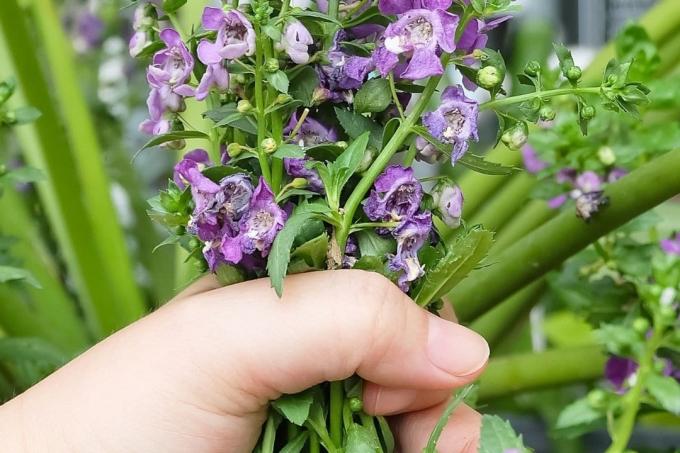
Table of Contents
- Ornamental sage species
- Cut the decorative sage
- Cutting instructions throughout the year
- 1. Cutting measure: winter cut
- 2. Cutting measure: summer cut
- 3. Pruning measure: entire growing season
- Cutting tool
- frequently asked Questions
Ornamental sage impresses in summer with a veritable display of flowers. To ensure that it stays that way, you should carry out a maintenance cut once a year according to the following instructions. How to properly cut decorative sage.
In a nutshell
- different cuts (times) possible on the ornamental sage
- Winter pruning for bushy growth
- stimulate second flowering with summer pruning and curb uncontrolled spread
- cut in any case in the event of disease or pest infestation
Ornamental sage species
Sage (Salvia) is a genus of plants within the mint family (Lamiaceae). Depending on the author, the genus includes 800 to 1,000 species. Garden sage (Salvia officinalis) and meadow sage (Salvia pratensis) are mainly used in the kitchen. There are also types of sage and their varieties that are kept as ornamental plants in the garden. However, not all ornamental sage species are winter hardy in this country. For example, species that get along well with the German winter are:
| Ornamental sage type | Winter hardiness |
|---|---|
| Grove sage (Salvia nemorosa) | to minus 29 degrees Celsius |
| Sticky Sage (Salvia glutinosa) | hardy (native species) |
| Clary Sage (Salvia sclarea) | to minus 29 degrees Celsius |
| Prairie sage (Salvia azurea) | to minus 23 degrees Celsius |
| Whorled sage (Salvia verticillata) | to minus 23 degrees Celsius |
| Silver sage (Salvia argentea) | to minus 29 degrees Celsius |
| Rod Sage (Salvia virgata) | hardy (naturalized species) |

The following species, for example, are conditionally hardy:
- Mexican sage (Salvia patens): down to -12 degrees Celsius
- Peach sage (Salvia gregii): down to -7 degrees Celsius
- Marsh sage (Salvia uliginosa): down to -18 degrees Celsius
Notice: Although the frost hardiness of the different types of ornamental sage is extremely different, they are treated the same in terms of cut.
Cut the decorative sage
Ornamental sage that is kept perennial should be pruned twice a year:
- Pruning (winter pruning)
- Removal of the faded panicle flowers (summer pruning)
Cutting instructions throughout the year
1. Cutting measure: winter cut
The ideal time for the so-called winter cut is in late winter, when no more periods of frost are to be expected. This may vary from region to region, but don't get scissors before the end of February.

The winter pruning is the pruning that is used to ensure that the sage grows bushy and dense. You can also restore the symmetry of the plant by pruning it. Follow the instructions below:
- for herbaceous species: cut off the stalk to about a hand's breadth above the ground
- for woody sage: shorten the shoots, but do not cut into the old wood
- Remove remaining dried and dead plant parts
Notice: Under no circumstances should you prune ornamental sage back in autumn, because the dying parts of the plant provide natural winter protection for the sage.
2. Cutting measure: summer cut
In contrast to the winter pruning, the summer pruning is not a nursing, but a cosmetic measure. Nonetheless, there is a lot to be said for cutting off what has faded:
- stimulates the plant to flower for a second time
- prevents uncontrolled spread by seeds
- Garden bed looks more neat

In order to achieve these goals, there is no need for guidance in the strict sense of the word. Simply cut off the faded panicle flowers. To prevent the sage from multiplying with seeds, use scissors as soon as the flower begins to wither. If natural distribution is desired, leave a few panicles.
3. Pruning measure: entire growing season
In addition to the winter and summer pruning, a pruning may be necessary if a disease or pest infestation sets in. In addition, individual dried shoots can also be removed in summer.
Cutting tool
You can use rose scissors or a knife to cut the sage. What is important is the cutting tool sharp is so that you can make a smooth cut.

frequently asked Questions
Since the dead parts of the plant serve as winter protection for the sage, you should refrain from pruning late-blooming species from October onwards.
When it comes to cutting, there is no difference between outdoor and bucket culture. However, the plants in the tub need winter protection if they overwinter outside. If you spend the winter indoors, you can trim the sage to save space.
Annual plants such as white sage (Salvia farinacea) or fire sage (Salvia splendens) do not need winter pruning because they do not survive the German winter outdoors. However, you should carry out the summer pruning to encourage a second flowering.



